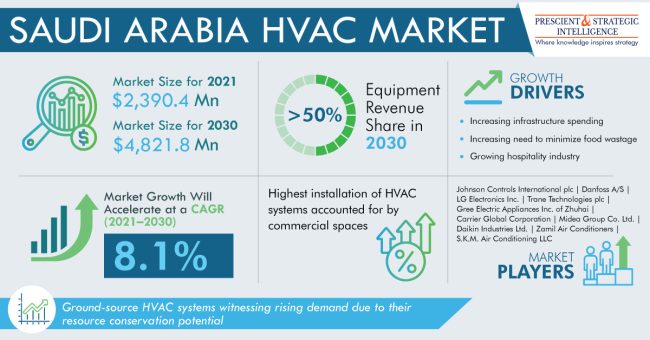From 1960 to 2020, the Saudi Arabian population increased from 4.09 million to 34.81 million, which was a growth of 751.9% in 60 years! Moreover, around 84% of the inhabitants live in big cities. This rising trend of urbanization is increasing by 1.8% yearly. With the Increasing population and growing infrastructure improvements in the commercial sector, the demand for HVAC systems is also on the rise in the kingdom.
The size of the Saudi Arabian HVAC market was estimated at $2,390.4 million in 2021, and it is likely to propel at an 8.1% CAGR from 2021 to 2030 and reach $4,821.8 million by 2030. The industry is primarily driven by the snowballing spending on infrastructure, the rising need to lessen the wastage of food, and the budding hospitality industry. It also has a lot to do with the increasing urbanization rate in the country.
One of the key trends in the industry is the rising inclination of people toward the adoption of smart VRF systems. Many people have started using energy-efficient technologies for reducing the consumption of energy and achieve sustainability. These systems have improved controls, enhanced monitoring systems, and smart thermostats, unlike the traditional systems. They also offer better temperature control and cleaner air, and their performance can be monitored by using a mobile app.
There is a high demand in Saudi Arabia for new VRF systems due to the harsh climate. Additionally, the booming construction of commercial spaces is the main reason for the growth of the Saudi Arabian HVAC market. For example, In Riyadh, the Qiddiya project was initiated in 2019, which is expected to be completed in 2022. This project is designed as a center of entertainment, arts, and sports. $8 billion has already been put into it, and it plans to host 17 million visitors in a year by 2035.
The largest revenue share was held by the commercial category in 2021. There is considerable support from the government of Saudi for the corporate and hospitality industries with the intention of minimizing its dependence on the trade of oil. Consequently, with the growing number of resorts, hotels, and office buildings, the demand of the commercial sector for this equipment is snowballing. In this regard, the investments by government and private parties propel the demand for HVAC systems in the kingdom.




